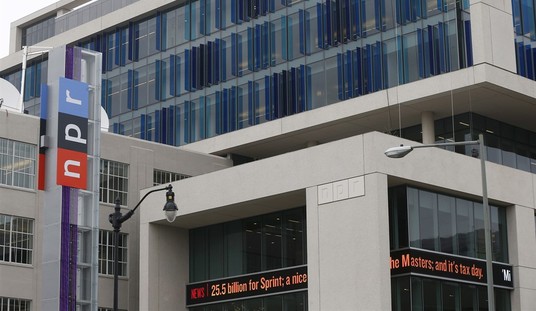There are 15 Republicans the pro-abortion groups EMILY’s List plans to target in 2016. They’ve effectively put them “on notice,” according to their president, Stephanie Schriock.
“The GOP trying to roll back the clock for women on choice is nothing new, but this year Republicans have been trying to chip away at Roe v. Wade like never before — from hijacking the nomination of Loretta Lynch to proposing some of the most extreme abortion bans we’ve ever seen,” she wrote:
Republicans in the House threw their support of states’ rights and their whining about federal government intrusion right out the window when they voted to overturn a law passed by the District of Columbia that would have protected workers from being fired for accessing reproductive health services like in vitro fertilization.And adding insult to injury, a handful of Republicans tried to do damage control by pushing to make birth control available over the counter — a move that some say would only make birth control more expensive.
In statehouses from Texas to Wisconsin to Kansas, we’ve seen what can happen when Republicans get full control of state governments — so we don’t even have to imagine what would happen if they got full control in Washington.
…
We’ll be putting more Republicans “On Notice” as the election cycle continues — and letting our network of more than three million members know every time we add more GOPers to the list.
First of all, the District of Columbia isn’t a state. The liberal talking point that Republican support for pro-life legislation goes against the less government rallying cry isn’t entirely accurate. Almost every time a conservative discusses less government intrusion, it’s pretty much in the economic realm. Regarding social issues, there are some activities conservatives feel that should be incentivized and dis-incentivized. Hence, why marriage should remain an entrenched part of our tax code; it’s a great anti-poverty program and provides a stable foundation for a society. And why the killing of the unborn shouldn’t be allowed considered morally acceptable.
Recommended
Second, the Loretta Lynch nomination wasn’t “hijacked;” it was botched by Democratic incompetence. And, by incompetence, I mean they didn’t read the human trafficking bill, which they held up–prompting Republicans to put a hold on the Lynch nomination. Sixty percent of American women support banning abortion at 20 weeks. It’s actually an immensely popular measure. In West Virginia, Republican and Democratic state lawmakers twice overrode Gov. Earl Tomblin’s veto. It’s now West Virginia law, though a legal challenge is probably going to be filed. This was Tomblin’s main objection to the bill–he has described himself as pro-life.
Yet, let’s go through the hit list. Out of the fifteen names listed–there will be more in due time–only four are listed as a tossup, with one labeled leaning Democratic … for now. The rest either lean Republican or a a solid Republican hold (via Roll Call):
- Rep. Rod Blum, a freshman from Iowa’s 1st District. Blum represents a district President Barack Obama carried by a 14-point margin in 2012, which makes Blum one of the most vulnerable incumbents on the map. Three Democrats are already running here, including Cedar Rapids City CouncilwomanMonica Vernon, the first House candidate EMILY’s List endorsed this cycle. Rothenberg & Gonzales Race Rating: Tossup.
- Rep. Mike Coffman, who has held Colorado’s competitive 6th District since 2008, even though Obama carried the district twice. Democrats are looking to recruit a female candidate here. State Senate Minority Leader Morgan Carroll has met with House leadership about a bid, and Centennial City Councilwoman Rebecca McClellan is also mulling a run. Rating: Republican Favored.
- Rep. Barbara Comstock, a freshman from the Northern Virginia-based 10th District. GOP presidential nominee Mitt Romney carried the district by a slim margin in 2012, while Obama won it four years earlier. Democrats are also looking to recruit a female candidate here. Rating: Leans Republican.
- Rep. Carlos Curbelo, a freshman from Florida’s Miami-based 26th District. Curbelo already has a challenge from former Miami-Dade County Democratic Chair Annette Taddeo, but others could also look to run in this district, which Obama carried by a 7-point margin in 2012. Rating: Tilts Republican.
- Rep. Rodney Davis, who won re-election by a large margin in 2014 in Illinois’ competitively drawn 13th District. Romney barely carried the seat in 2012, while Obama won it by an 11-point margin four years earlier. Democrats have yet to find a candidate to face Davis next fall. Rating: Safe Republican.
- Rep. Dan Donovan, who won New York’s Staten Island-based 11th District earlier this month in a special election to succeed disgraced ex-Rep. Michael G. Grimm. Democrats are looking at state Sen. Diane J. Savino as a possible recruit. Rating: Safe Republican.
- Rep. Cresent Hardy, a freshman from Nevada’s 4th District. At least three Democrats are looking to challenge Hardy in this seat, which Obama won by an 11-point margin in 2012. Two of those candidates are women. Rating: Tilts Democratic.
- Rep. John Katko, a freshman from New York’s Syracuse-based 24th District. Obama carried the seat by a 16-point margin in 2012, making it one of the most Democratic districts held by a Republican in the country. Rating: Tossup.
- Rep. John Kline, a perennial Democratic target in Minnesota’s 2nd District, which Obama carried twice. Two women, health care executive Angie Craig and physician Mary Lawrence, have announced bids to challenge Kline next fall. Rating: Safe Republican.
- Rep. Steve Knight, a freshman from California’s 25th District. Knight, who had fundraising troubles since arriving in Congress, has two Democratic opponents already. They include Maria Gutzeit, a member of the Santa Clarita Water Board. Rating: Leans Republican.
- Rep. Martha McSally, a freshman Republican who won Arizona’s 2nd District in 2014 by one of the slimmest margins in the country. Rating: Leans Republican.
- Rep. Bruce Poliquin, the freshman from Maine’s 2nd District, who faces a rematch with former state Sen. Emily Cain. EMILY’s List backed Cain in 2014. Rating: Tossup.
- Rep. Tim Walberg, the Michigan Republican serving his fourth, non-consecutive term. Romney won Walberg’s 7th District by a 3-point margin in 2012, while Obama carried it by the same margin four years earlier. Democrats tout their recruit, state Rep. Gretchen Driskell, as a top-tier challenger. Rating: Tilts Republican.
- Rep. David Young, a freshman Republican from Iowa’s 3rd District. Obama carried this Des Moines district twice. Young could face a rematch with the Democrat he defeated in 2014, former state Sen. Staci Appel. Rating: Tossup.
- Rep. Lee Zeldin, a freshman who represents New York’s 1st District. Obama won the seat by a 1-point margin in 2012. Two Democrats are already seeking to challenge Zeldin, including one woman, Southampton Town Supervisor Anna Throne-Holst. Rating: Leans Republican.
Another thing to look at is EMILY’s List’s partnership with Elle magazine. Women’s magazines are influential, especially with single, urban women; they have reach–and conservatives should try to make moves in this market. Glenn Reynolds (aka Instapundit) has stated this view back in 2012. Cosmopolitan magazine plunged headlong into the 2014 political trenches by offering endorsements in key races that cycle. Many of their candidates didn’t win, but that doesn’t mean the right should ignore this substantial share of the media market. We must try to infiltrate all areas of culture (via Hadas Gold, Politico):
EMILY's List has teamed up with Elle magazine to publish political and economic trend reports based off of regular polling of men and women in the lead-up to the 2016 elections.American Women, the research organizational arm of the advocacy group for female Democratic candidates, is in charge of the research and polling.
“We’re looking forward to working with American Women to uncover, interpret, and explore the key issues weighing on the minds of women and men as we enter election season, which seems to be upon us already,” Robbie Myers, editor-in-chief of Elle, said in a statement. “Engaging in meaningful partnerships that facilitate a genuine conversation about ideas — those things that women really need to talk about — is such an important part of what we do at Elle.”
These magazines, like Cosmo, will probably only espouse progressive ideas (no, wait; that’s pretty much assured)–and endorse solely pro-choice candidates. Now, Hadas Gold did a deep-dive article in Politico on women’s magazines, noting that their articles on Clinton are “enough to make Republicans scream.” It’s true, but it also lends Republicans to just ignore this segment of the market. Gold had the figures [emphasis mine]:
The magazines boast enormous audiences, especially among the younger women whom Clinton’s camp has always counted on for support — millions of readers, according to Hearst, which owns Cosmopolitan, Marie Claire and Elle. Cosmo reports its “reach” (an audience measure combining print and digital readers) to be 53 million, Glamour’s about 28 million, Vogue’s at 28 million, Elle at 21 million.It’s a hugely important demographic for Clinton and Republican rivals, too: According to the Center for American Women and Politics at Rutgers University, women have cast 4 million to 7 million more votes than men in recent elections. Additionally, a higher proportion of women under the age of 44 voted in the past four presidential elections. That pattern is reversed among older voters. The main audience of these magazines? Young women.
Yet, Gold touched upon the fact that these magazines might also not lean left as well; a point I’m not so sure about, even if these magazines profiled prolific Republican women in past articles. Moreover, even though their candidate profiles aren’t considered the “most serious,” their impact can still be profound given that they usually focus on personal stories. These stories could humanize a candidate, could potentially make him or her likable to the electorate, and that could lead to some people casting votes in their favor on Election Day. Humanization is something that Mitt Romney desperately needed in 2012.
The magazines don’t ignore the GOP. Republican presidential candidate Carly Fiorina, Reps. Elise Stefanik, Martha McSally, Martha Roby and Jaime Herrera Beutler have all been featured in print or online over the past few months. In previous years, Vogue has written about Laura Bush, Condoleezza Rice, Nikki Haley, Sarah Palin, Rand Paul and other Republicans. And as the cycle gets moving, more GOP women will probably be covered. But you’re not likely to see articles defending the Supreme Court’s Hobby Lobby decision, or arguments against federal regulations requiring equal pay for women.…
[ Glamour Editor-in-Chief Cindi] Leive, whose magazine featured Michelle Obama on its May cover, pushed back against the idea that women’s magazines lean left.
“I think there’s a misconception that fashion or women’s fashion magazines lean one way, that we’re Democrats. So part of our coverage that we really adhere to is a fairness and a philosophy of being pro-woman, nonpartisan,” she said, noting that last fall she interviewed Stefanik and Rep. Cathy McMorris Rodgers (R-Wash.). “We have 20 million print and online readers, and these are women whose political views are not monolithic. We keep that top of mind when it comes to our coverage of Washington and politics.”
The magazines know they’re not publishing the most serious political profiles. They tend to focus more on the personal stories behind the candidate, or what it’s like being a powerful woman, than on their policies or positions on major issues.
























Join the conversation as a VIP Member